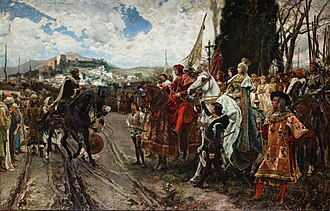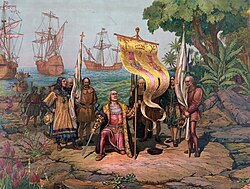This article needs additional citations for verification. (September 2022) |
| Millennium |
|---|
| 2nd millennium |
| Centuries |
| Timelines |
| State leaders |
| Decades |
| Categories: |
|
Births – Deaths Establishments – Disestablishments |



The 15th century was the century which spans the Julian calendar dates from 1 January 1401 (represented by the Roman numerals MCDI) to 31 December 1500 (MD).
In Europe, the 15th century includes parts of the Late Middle Ages, the Early Renaissance, and the early modern period. Many technological, social and cultural developments of the 15th century can in retrospect be seen as heralding the "European miracle" of the following centuries. The architectural perspective, and the modern fields which are known today as banking and accounting were founded in Italy.
The Hundred Years' War ended with a decisive French victory over the English in the Battle of Castillon. Financial troubles in England following the conflict resulted in the Wars of the Roses, a series of dynastic wars for the throne of England. The conflicts ended with the defeat of Richard III by Henry VII at the Battle of Bosworth Field, establishing the Tudor dynasty in the later part of the century.
Constantinople, known as the capital of the world and the capital of the Byzantine Empire, fell to the emerging Muslim Ottoman Turks, marking the end of the tremendously influential Byzantine Empire and, for some historians, the end of the Middle Ages.[1] This led to the migration of Greek scholars and texts to Italy, while Johannes Gutenberg's invention of a mechanical movable type began the printing press. These two events played key roles in the development of the Renaissance.[2][3] The Roman papacy was split in two parts in Europe for decades (the so-called Western Schism), until the Council of Constance. The division of the Catholic Church and the unrest associated with the Hussite movement would become factors in the rise of the Protestant Reformation in the following century.
Islamic Spain became dissolved through the Christian Reconquista, followed by the forced conversions and the Muslim rebellion,[4] ending over seven centuries of Islamic rule and returning southern Spain to Christian rulers.
The spices, wines and precious metals of the Bengal Sultanate[5] had attracted European traders to trade with Bengal, but the trade was subsequently lower, due to the rise of the Ottoman Empire, which introduced new taxes and tariffs against European traders. This had led to explorers like Christopher Columbus finding a route to reach India, which eventually reached the Americas. Explorers like Vasco da Gama, a Portuguese traveller, also found a route to reach to India from the African coast.
In Asia, the Timurid Empire collapsed and the Afghan Pashtun Lodi dynasty took control of the Delhi Sultanate. Under the rule of the Yongle Emperor, who built the Forbidden City and commanded Zheng He to explore the world overseas, the Ming dynasty's territory reached its pinnacle.
In Africa, the spread of Islam led to the destruction of the Christian kingdoms of Nubia, by the end of the century, leaving only Alodia (which was to collapse in 1504). The formerly vast Mali Empire teetered on the brink of collapse, under pressure from the rising Songhai Empire.
In the Americas, both the Aztec Empire and the Inca Empire reached the peak of their influence, but the voyages of Christopher Columbus and other European voyages of discovery in the Americas, beginning the European colonization of the Americas, changed the course of modern history.
- ^ Crowley, Roger (2006). Constantinople: The Last Great Siege, 1453. Faber. ISBN 0-571-22185-8. (reviewed by Foster, Charles (22 September 2006). "The Conquestof Constantinople and the end of empire". Contemporary Review. Archived from the original on 22 August 2009.
It is the end of the Middle Ages
) - ^ Encyclopædia Britannica, Renaissance, 2008, O.Ed.
- ^ McLuhan 1962; Eisenstein 1980; Febvre & Martin 1997; Man 2002
- ^ Harvey 2005, p. 14.
- ^ Nanda, J. N (2005). Bengal: the unique state. Concept Publishing Company. p. 10. 2005. ISBN 978-81-8069-149-2.
Bengal [...] was rich in the production and export of grain, salt, fruit, liquors and wines, precious metals and ornaments besides the output of its handlooms in silk and cotton. Europe referred to Bengal as the richest country to trade with.